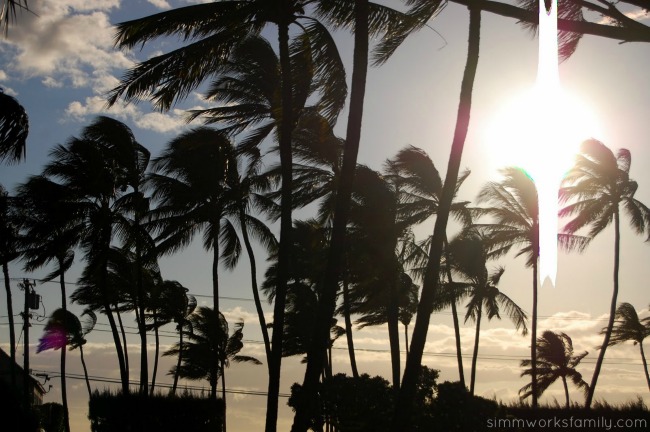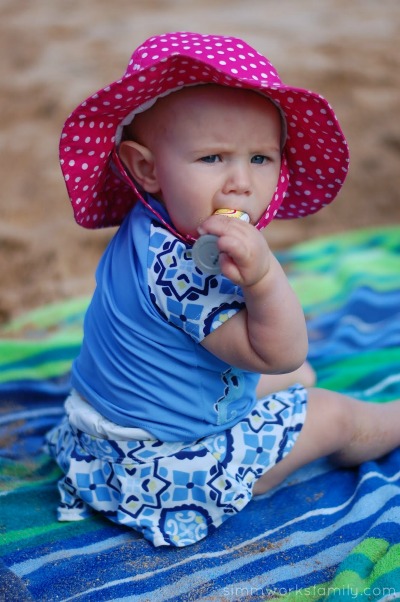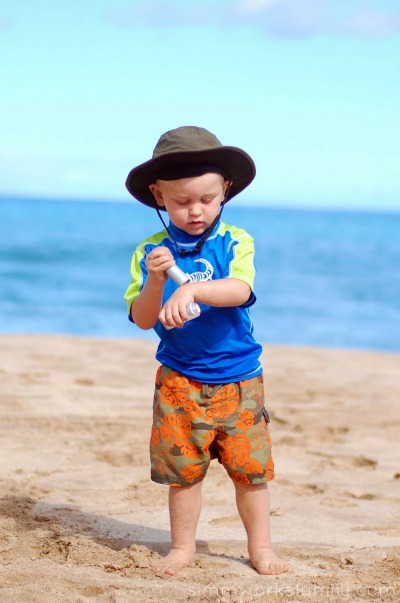Yes, I know a post like this at the end of summer seems ill timed. But is it? Once the end of summer comes most stop thinking about preventing sun damage for themselves and their children. But everyday protection from the suns harmful rays is very important to remember and continue daily. The American Academy of Dermatology recommends that, regardless of skin type, a broad-spectrum (protects against UVA and UVB rays), water-resistant sunscreen with a Sun Protection Factor (SPF) of at least 30 should be used year-round.
My family just returned from a much needed vacation to Hawaii. While we were there we applied sunscreen to the children, and ourselves, daily. No matter if we were going to the pool, walking the beach or hitting up a craft fair. And I started to realize that we should be doing this every day, not just when we’re on vacation or during the summer, but at home as well.
So I started to do a bit of research when we returned home and found that more than 3.5 million skin cancers are diagnosed in more than 2 million people annually. Many studies have found an association between sunburns and enhanced risk for melanoma, the deadliest form of skin cancer.
Unprotected sun exposure is even more dangerous for kids with:
- moles on their skin (or whose parents have a tendency to develop moles)
- very fair skin and hair
- a family history of skin cancer, including melanoma
And seeing as though my husband just had a bit of skin cancer removed from his neck, and we are very fair skinned, my children need to be very cautious about their sun exposure. So we’ve come up with a plan with help from Kids Health. Here’s what we now do to insure proper protection from the sun’s harmful rays.
Avoid the Strongest Rays of the Day
We stay indoors or in the shade between the hours of 10am and 2pm. If we need to be outdoors during this time we cover up, apply sunscreen and are conscious of the time we spend in the sun. Even if we are outdoors during this time on cloudy or cool days we still follow the same procedure. The “invisible sun” can be the most dangerous because we cannot feel it’s rays burning our skin. But later on a sunburn may appear if sunscreen was not applied or re-applied.
Cover Up
One of the best ways to protect your skin from UV rays is to cover up. Wear clothing that covers your skin. To make sure that the clothing you are wearing is, in fact, keeping the UV rays from hitting your skin simply place your hand inside the garment. If you can see your skin through the fabric then it is not protecting you from UV rays.
Because infants have thinner skin and underdeveloped melanin, their skin burns more easily than that of older kids. But sunscreen should not be applied to babies under 6 months of age, so they absolutely must be kept out of the sun whenever possible. If your infant must be in the sun, dress him or her in clothing that covers the body, including hats with wide brims to shadow the face. Use an umbrella or blanket to create shade.
Use Sunscreen Consistently
Choose a sunscreen that states on the label that it protects against both UVA and UVB rays (referred to as “broad-spectrum” sunscreen). In general, sunscreens provide better protections against UVB rays than UVA rays, making signs of skin aging a risk even with consistent use of sunscreen. To avoid possible skin allergy, don’t use sunscreens with PABA; if your child has sensitive skin, look for a product with the active ingredient titanium dioxide (a chemical-free block). We prefer to use CA Baby No Fragrance SPF 30+ Sunscreen Lotion. It’s thick and coats the skin well so I know I’m getting every nook and cranny of skin. And for an easy, on-the-go solution we love the CA Baby No Fragrance SPF 30+ Sunblock Stick.
Use Protective Eyewear for Kids
The best way to protect a child’s eyes is to wear sunglasses. If your child will allow you to put sun glasses on them make sure you choose a pair that provide 100% UV protection. A great way to get your child interested in wearing sunglasses is to pick out the craziest, largest pair of sunglasses for yourself and wear them all the time. Then ask your child if they want a pair of cool glasses for themselves. More likely than not, they’ll want to be just like you!
If not, invest in an awesome, wide brimmed hat that shades their eyes. Hats with straps work best for babies who might pull sunglasses off in a split second. I’ve found that even sunglasses that wrap around a child’s head sometimes won’t last long on certain kids. But remember to try, try again. Kids might not like something at first but if you’re persistent you may break them down.
Double-Check Medications
Some medications increase the skin’s sensitivity to UV rays. As a result, even kids with skin that tends not to burn easily can develop a severe sunburn in just minutes when taking certain medications. Fair-skinned kids, of course, are even more vulnerable.
Ask your doctor or pharmacist if any prescription (especially antibiotics and acne medications) and over-the-counter medications your child is taking can increase sun sensitivity. If so, always take extra sun precautions. The best protection is simply covering up or staying indoors; even sunscreen can’t always protect skin from sun sensitivity caused by medications.
Be Sun Safe Yourself
Be a good role model by consistently wearing sunscreen with SPF 30 or greater, using sunglasses, and limiting your time in the sun. These preventive behaviors not only reduce your risk of sun damage, but teach your kids good sun sense.
There are so many products out there now to help aid in sun protection. I currently use a daily moisturizer and daily lotion with SPF built right in from Eucerin that I love. I don’t want to smell like sunscreen so these alternatives are easy for me to use daily and my children know I’m protecting myself.
And please, please make sure your kids don’t use tanning beds at any time, even to “prepare” for a trip to a warm climate. Both UVA and UVA/UVB tanning beds produce sunburn. And there is an increase in the risk of melanoma in people who have used tanning beds before the age of 35.










